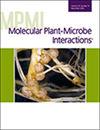求助PDF
{"title":"沙氏囊线虫诱导拟南芥根系激光显微解剖合胞体的转录组和细胞类型特征分析。","authors":"Xunliang Liu, Melissa G Mitchum","doi":"10.1094/MPMI-03-25-0024-R","DOIUrl":null,"url":null,"abstract":"<p><p>Cyst nematodes establish a highly specialized feeding structure called a syncytium in host roots by secreting effectors into a selected host cell that reprogram host development programs. The selected host cell undergoes distinct morphological, physiological, and gene expression changes, resulting in the fusion of hundreds of cells to create a novel cell type that does not normally exist in the host. Here, we profiled the transcriptome of the syncytium induced by the beet cyst nematode (BCN) <i>Heterodera schachtii</i> in <i>Arabidopsis</i> roots using laser capture microdissection and RNA sequencing. Aside from biological processes that are expected to be altered by nematode infection, we also found that genes annotated in nitrate and iron ion signaling and transport-related biological processes are significantly overrepresented in genes that are downregulated by BCN infection, suggesting that these ions may play important roles in BCN infection. Comparing the syncytium transcriptome with that of various root cell types showed that it was overrepresented by genes that are enriched in cells marked by <i>ATHB15</i>, a member of the HD-ZIP III transcription factor family that is highly expressed in the stem cell organizer of the root vasculature. These results suggest that the syncytium may partially adopt the molecular signature of a stem cell organizer, consistent with our previous hypothesis that BCN uses a stem cell organizer as an intermediate status for syncytium formation. [Formula: see text] Copyright © 2025 The Author(s). This is an open access article distributed under the CC BY-NC-ND 4.0 International license.</p>","PeriodicalId":19009,"journal":{"name":"Molecular Plant-microbe Interactions","volume":" ","pages":"529-542"},"PeriodicalIF":3.4000,"publicationDate":"2025-07-01","publicationTypes":"Journal Article","fieldsOfStudy":null,"isOpenAccess":false,"openAccessPdf":"","citationCount":"0","resultStr":"{\"title\":\"Transcriptome and Cell Type Signature Analysis of Laser-Microdissected Syncytia Induced by the Cyst Nematode <i>Heterodera schachtii</i> in <i>Arabidopsis</i> Roots.\",\"authors\":\"Xunliang Liu, Melissa G Mitchum\",\"doi\":\"10.1094/MPMI-03-25-0024-R\",\"DOIUrl\":null,\"url\":null,\"abstract\":\"<p><p>Cyst nematodes establish a highly specialized feeding structure called a syncytium in host roots by secreting effectors into a selected host cell that reprogram host development programs. The selected host cell undergoes distinct morphological, physiological, and gene expression changes, resulting in the fusion of hundreds of cells to create a novel cell type that does not normally exist in the host. Here, we profiled the transcriptome of the syncytium induced by the beet cyst nematode (BCN) <i>Heterodera schachtii</i> in <i>Arabidopsis</i> roots using laser capture microdissection and RNA sequencing. Aside from biological processes that are expected to be altered by nematode infection, we also found that genes annotated in nitrate and iron ion signaling and transport-related biological processes are significantly overrepresented in genes that are downregulated by BCN infection, suggesting that these ions may play important roles in BCN infection. Comparing the syncytium transcriptome with that of various root cell types showed that it was overrepresented by genes that are enriched in cells marked by <i>ATHB15</i>, a member of the HD-ZIP III transcription factor family that is highly expressed in the stem cell organizer of the root vasculature. These results suggest that the syncytium may partially adopt the molecular signature of a stem cell organizer, consistent with our previous hypothesis that BCN uses a stem cell organizer as an intermediate status for syncytium formation. [Formula: see text] Copyright © 2025 The Author(s). This is an open access article distributed under the CC BY-NC-ND 4.0 International license.</p>\",\"PeriodicalId\":19009,\"journal\":{\"name\":\"Molecular Plant-microbe Interactions\",\"volume\":\" \",\"pages\":\"529-542\"},\"PeriodicalIF\":3.4000,\"publicationDate\":\"2025-07-01\",\"publicationTypes\":\"Journal Article\",\"fieldsOfStudy\":null,\"isOpenAccess\":false,\"openAccessPdf\":\"\",\"citationCount\":\"0\",\"resultStr\":null,\"platform\":\"Semanticscholar\",\"paperid\":null,\"PeriodicalName\":\"Molecular Plant-microbe Interactions\",\"FirstCategoryId\":\"99\",\"ListUrlMain\":\"https://doi.org/10.1094/MPMI-03-25-0024-R\",\"RegionNum\":3,\"RegionCategory\":\"生物学\",\"ArticlePicture\":[],\"TitleCN\":null,\"AbstractTextCN\":null,\"PMCID\":null,\"EPubDate\":\"2025/8/18 0:00:00\",\"PubModel\":\"Epub\",\"JCR\":\"Q2\",\"JCRName\":\"BIOCHEMISTRY & MOLECULAR BIOLOGY\",\"Score\":null,\"Total\":0}","platform":"Semanticscholar","paperid":null,"PeriodicalName":"Molecular Plant-microbe Interactions","FirstCategoryId":"99","ListUrlMain":"https://doi.org/10.1094/MPMI-03-25-0024-R","RegionNum":3,"RegionCategory":"生物学","ArticlePicture":[],"TitleCN":null,"AbstractTextCN":null,"PMCID":null,"EPubDate":"2025/8/18 0:00:00","PubModel":"Epub","JCR":"Q2","JCRName":"BIOCHEMISTRY & MOLECULAR BIOLOGY","Score":null,"Total":0}
引用次数: 0
引用
批量引用

 求助内容:
求助内容: 应助结果提醒方式:
应助结果提醒方式:


